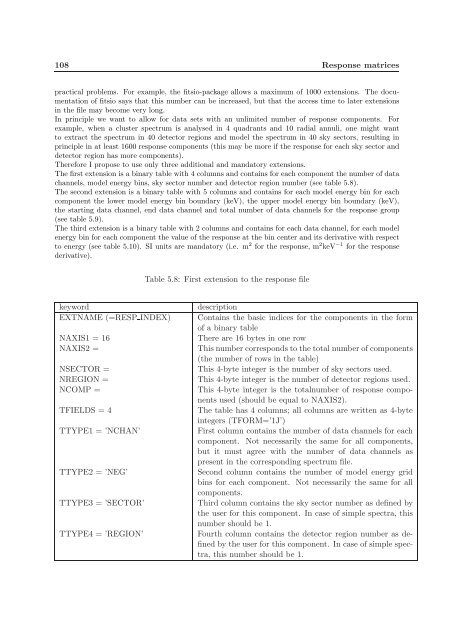SPEX User's Manual - SRON
SPEX User's Manual - SRON
SPEX User's Manual - SRON
Create successful ePaper yourself
Turn your PDF publications into a flip-book with our unique Google optimized e-Paper software.
108 Response matrices<br />
practical problems. For example, the fitsio-package allows a maximum of 1000 extensions. The documentation<br />
of fitsio says that this number can be increased, but that the access time to later extensions<br />
in the file may become very long.<br />
In principle we want to allow for data sets with an unlimited number of response components. For<br />
example, when a cluster spectrum is analysed in 4 quadrants and 10 radial annuli, one might want<br />
to extract the spectrum in 40 detector regions and model the spectrum in 40 sky sectors, resulting in<br />
principle in at least 1600 response components (this may be more if the response for each sky sector and<br />
detector region has more components).<br />
Therefore I propose to use only three additional and mandatory extensions.<br />
The first extension is a binary table with 4 columns and contains for each component the number of data<br />
channels, model energy bins, sky sector number and detector region number (see table 5.8).<br />
The second extension is a binary table with 5 columns and contains for each model energy bin for each<br />
component the lower model energy bin boundary (keV), the upper model energy bin boundary (keV),<br />
the starting data channel, end data channel and total number of data channels for the response group<br />
(see table 5.9).<br />
The third extension is a binary table with 2 columns and contains for each data channel, for each model<br />
energy bin for each component the value of the response at the bin center and its derivative with respect<br />
to energy (see table 5.10). SI units are mandatory (i.e. m 2 for the response, m 2 keV −1 for the response<br />
derivative).<br />
Table 5.8: First extension to the response file<br />
keyword<br />
EXTNAME (=RESP INDEX)<br />
NAXIS1 = 16<br />
NAXIS2 =<br />
NSECTOR =<br />
NREGION =<br />
NCOMP =<br />
TFIELDS = 4<br />
TTYPE1 = ’NCHAN’<br />
TTYPE2 = ’NEG’<br />
TTYPE3 = ’SECTOR’<br />
TTYPE4 = ’REGION’<br />
description<br />
Contains the basic indices for the components in the form<br />
of a binary table<br />
There are 16 bytes in one row<br />
This number corresponds to the total number of components<br />
(the number of rows in the table)<br />
This 4-byte integer is the number of sky sectors used.<br />
This 4-byte integer is the number of detector regions used.<br />
This 4-byte integer is the totalnumber of response components<br />
used (should be equal to NAXIS2).<br />
The table has 4 columns; all columns are written as 4-byte<br />
integers (TFORM=’1J’)<br />
First column contains the number of data channels for each<br />
component. Not necessarily the same for all components,<br />
but it must agree with the number of data channels as<br />
present in the corresponding spectrum file.<br />
Second column contains the number of model energy grid<br />
bins for each component. Not necessarily the same for all<br />
components.<br />
Third column contains the sky sector number as defined by<br />
the user for this component. In case of simple spectra, this<br />
number should be 1.<br />
Fourth column contains the detector region number as defined<br />
by the user for this component. In case of simple spectra,<br />
this number should be 1.

















